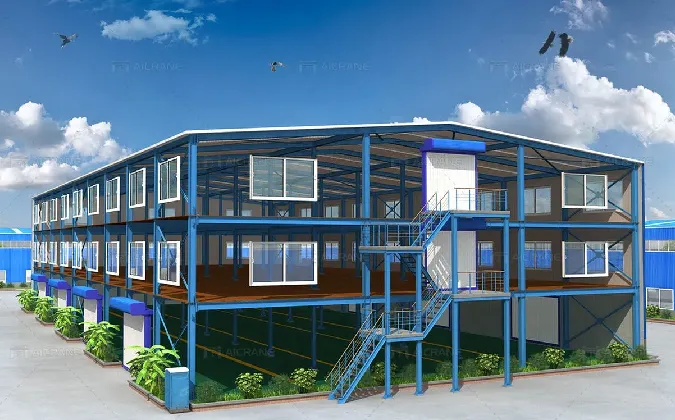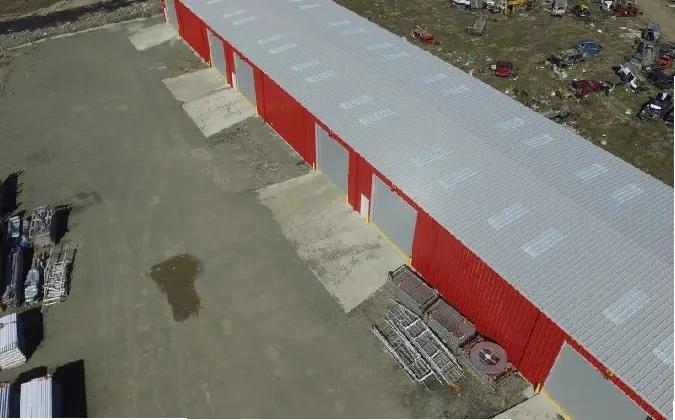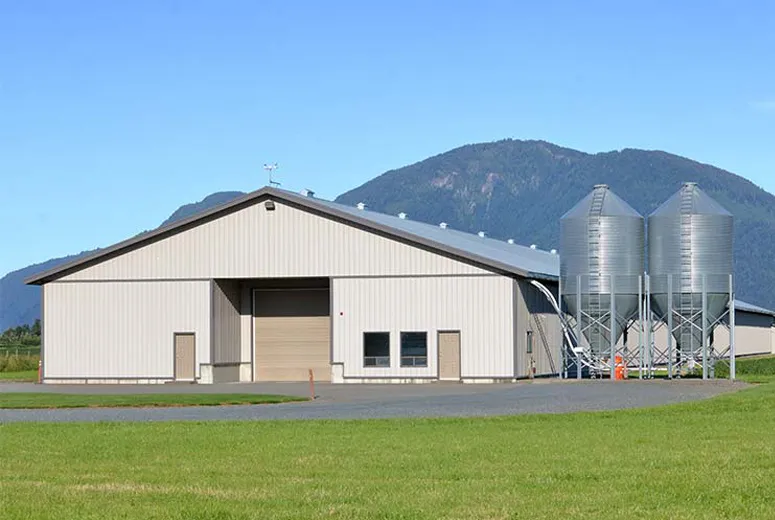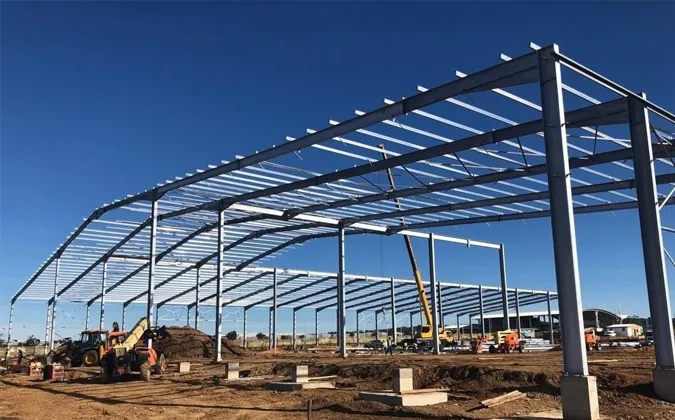Sep . 11, 2025 09:40 Back to list
Introduction to Portal Frame Steel Sheds
In modern industrial and commercial construction, the steel portal frame shed stands as a cornerstone for robust, adaptable, and cost-effective structural solutions. These pre-engineered steel buildings are characterized by their clear span capabilities, offering unparalleled flexibility for various applications ranging from large-scale warehouses and manufacturing facilities to agricultural storage and retail spaces. Their design relies on rigid frames, typically fabricated from hot-rolled or cold-formed steel sections, which provide inherent stability and structural integrity without the need for internal columns. This clear span advantage is crucial for maximizing usable internal space, facilitating efficient layout planning, and accommodating diverse operational requirements, including heavy machinery, automated systems, and expansive storage.
The robust nature of portal frame construction ensures exceptional durability and longevity, often exceeding fifty years of service life with minimal maintenance. This makes them a preferred choice for sectors demanding high performance and reliability, such as petrochemical, metallurgy, and water supply & drainage, where structural integrity is paramount. Furthermore, the inherent strength of steel allows for rapid construction and allows for the integration of advanced features like overhead cranes, specialized insulation, and complex ventilation systems. The focus of this detailed overview is to delve into the technical intricacies, application versatility, and strategic advantages that make steel portal frame sheds an indispensable asset for forward-thinking businesses.
Industry Trends and Market Outlook
The global market for pre-engineered buildings, heavily influenced by the demand for steel portal frame sheds, is experiencing substantial growth. Projections indicate a compound annual growth rate (CAGR) of approximately 9.5% from 2023 to 2030, driven by rapid industrialization, urbanization, and the increasing adoption of sustainable construction practices across developing economies [1]. Key trends shaping this market include:
- Sustainability and Green Building Initiatives: A growing emphasis on environmentally friendly construction has accelerated the adoption of steel structures due to steel's recyclability and the energy efficiency achievable through integrated insulation systems. Modern portal frame designs are optimized for minimal material waste and often incorporate renewable energy solutions.
- Technological Advancements in Design and Fabrication: The integration of Building Information Modeling (BIM) and advanced CAD/CAM software has revolutionized the design and fabrication process, allowing for greater precision, reduced error rates, and faster project turnaround times for steel portal frame sheds. Automated welding and cutting technologies further enhance efficiency and quality.
- Increased Demand for Modular and Customizable Solutions: Businesses require flexible infrastructure that can adapt to changing operational needs. Portal frame structures excel in this regard, offering extensive customization options in terms of size, bay spacing, roof pitch, and accessory integration.
- Resilience and Durability: With escalating concerns over extreme weather events, there is a heightened demand for structures that can withstand high winds, heavy snow loads, and seismic activity. The inherent strength and ductility of steel make portal frames exceptionally resilient.
- Logistics and Warehousing Boom: The e-commerce explosion continues to fuel demand for large, clear-span warehouses and distribution centers, where the rapid deployment and cost-effectiveness of steel portal frame sheds are significant advantages.
These trends collectively position steel portal frame sheds as a vital component in meeting the evolving demands for efficient, sustainable, and resilient infrastructure worldwide.
Technical Specifications and Design Principles
The structural integrity and performance of a steel portal frame shed are governed by meticulous technical specifications and robust design principles. These structures are typically composed of primary and secondary steel members.
Key Structural Components:
- Columns (Stanchions): Vertical load-bearing elements, typically I-beams or H-beams, anchored to concrete foundations.
- Rafters: Sloping roof beams that connect to the columns, forming the rigid portal frame. These are often tapered or haunched to optimize material usage and increase strength at points of high bending moment.
- Purlins: Horizontal members spanning between rafters, supporting the roof cladding.
- Girts: Horizontal members spanning between columns, supporting the wall cladding.
- Bracing: Essential for resisting lateral forces (wind, seismic), typically in the form of tension rods or angle sections in roof and wall planes.
- Shed portal frame brackets: Critical connection elements, often manufactured from robust steel plates and sections, ensuring the rigid joint between columns and rafters. These brackets are precision-engineered to transfer bending moments and shear forces effectively, forming the cornerstone of the portal frame's stability.
Material Specifications:
High-strength structural steel is universally employed, with common grades including Q235B (equivalent to ASTM A36) and Q345B (equivalent to ASTM A572 Grade 50) for primary structural members. These grades offer excellent yield strength and weldability. Surface protection is achieved through various methods:
- Primer Coating: Standard practice, typically a zinc-rich epoxy primer for initial corrosion protection.
- Finish Coats: Alkyd, epoxy, or polyurethane paint systems for enhanced durability and aesthetics.
- Hot-Dip Galvanization: For environments requiring superior corrosion resistance, particularly in coastal or chemical-exposed areas.
Typical Product Specifications for Portal Frame Steel Sheds:
| Parameter | Description / Value Range |
|---|---|
| Structure Type | Portal Frame Structure (Rigid Frame) |
| Main Material | Q235B, Q345B (GB/T 1591-2018 equivalent to ASTM A36, A572 Gr.50) |
| Span (Clear) | 10m - 50m (customizable beyond) |
| Eave Height | 4m - 18m (customizable) |
| Bay Spacing | 6m - 9m (optimized for efficiency) |
| Roof Pitch | 1:10 to 1:20 (typical), customizable |
| Wind Load Capacity | Up to 0.9 kN/m² (equivalent to 140 mph / 225 km/h) per ASCE 7 or local codes |
| Snow Load Capacity | Up to 2.0 kN/m² (customizable based on geographic location) |
| Seismic Design | Designed to relevant seismic zones (e.g., IBC, Eurocode 8) |
| Corrosion Protection | Zinc-rich epoxy primer (standard), Hot-dip galvanization (optional) |
| Service Life | Typically 50 years with proper maintenance |
These parameters are engineered to comply with international building codes and standards such as ISO 9001, ANSI/AISC 360, and local regulatory requirements, ensuring structural integrity and safety.
Manufacturing Process of a Steel Portal Frame Shed
The fabrication of a steel portal frame shed is a highly standardized and precision-driven process, ensuring quality and structural integrity. Hongjishunda adheres to stringent quality control measures throughout each stage, from raw material selection to final assembly preparation.
Process Flow:
1. Design & Engineering
Utilizing advanced CAD/BIM software, structural engineers design the frame based on client specifications, local building codes (e.g., ASCE 7, Eurocode 3), and load calculations (wind, snow, seismic). Material optimization and connection details for shed portal frame brackets are finalized.
2. Material Procurement & Inspection
High-grade structural steel (e.g., Q235B, Q345B) is sourced from certified mills. Incoming materials undergo rigorous inspection for chemical composition, mechanical properties, and dimensional accuracy, adhering to ISO 9001 standards.
3. Cutting & Shaping
Steel plates and sections are precisely cut to size and shape using CNC plasma or laser cutting machines. This ensures high accuracy and minimal material waste. Components like haunches for rafters and base plates for columns are formed.
4. Drilling & Punching
Holes for bolted connections and secondary members are accurately drilled or punched using CNC machinery, ensuring perfect alignment for on-site assembly. This phase also includes fabrication of connection plates and shed portal frame brackets.
5. Welding & Assembly
Individual components are welded together to form columns, rafters, and other primary members. Automated welding robots and skilled welders ensure high-quality, consistent welds in accordance with AWS D1.1 standards. This is a critical step for structural integrity.
6. Surface Preparation & Coating
Steel members undergo thorough surface preparation, typically abrasive blasting (Sa2.5 standard), to remove rust and mill scale. This is followed by the application of multi-coat paint systems (e.g., zinc-rich epoxy primer + polyurethane finish) or hot-dip galvanization for enhanced corrosion resistance, extending the service life significantly.
7. Quality Control & Testing
Throughout fabrication, strict quality control (QC) checks are performed. This includes dimensional verification, weld inspection (NDT methods like ultrasonic or magnetic particle testing), and coating thickness checks. All processes conform to ISO standards (e.g., ISO 3834 for welding, ISO 12944 for corrosion protection).
8. Pre-assembly & Shipping
For complex projects, some components may be pre-assembled to verify fit. All members are carefully marked, bundled, and packaged for safe and efficient transport to the construction site. This meticulous preparation streamlines on-site erection.

Image: Advanced fabrication techniques ensure precision for every steel portal frame shed component.
This rigorous process ensures that every steel portal frame shed delivered meets the highest standards of quality, safety, and performance, crucial for demanding applications in petrochemical, metallurgy, and water supply & drainage industries where long-term corrosion resistance and structural integrity are paramount.
Technical Advantages of Steel Portal Frame Sheds
The selection of a steel portal frame shed offers a multitude of technical and operational advantages over traditional construction methods, making it a superior choice for various industrial and commercial projects.
- Exceptional Durability and Longevity: Fabricated from high-strength structural steel, these sheds are engineered to withstand severe weather conditions, seismic activity, and heavy industrial use. With proper corrosion protection (e.g., hot-dip galvanization or multi-layer paint systems), they offer a service life of 50 years or more, significantly reducing long-term capital expenditure.
- Superior Corrosion Resistance: For industries like petrochemical and water supply & drainage, exposure to corrosive agents is a constant threat. Advanced coating systems or galvanization applied to steel portal frame shed components provide a robust barrier against chemical degradation, rust, and environmental elements, ensuring structural integrity even in harsh operational environments.
- Rapid Construction and Project Timelines: Pre-engineered components are fabricated off-site under controlled conditions, arriving at the site ready for assembly. This modular approach drastically reduces on-site construction time, labor costs, and potential for delays compared to conventional building methods. A typical 1,000 sqm warehouse can be erected in weeks rather than months.
- Cost-Effectiveness: While initial material costs might appear higher than some alternatives, the overall life-cycle cost of a steel portal frame shed is often lower due to faster construction, reduced labor, minimal maintenance requirements, and superior longevity. The optimization of steel sections through precise engineering also contributes to material efficiency.
- Unparalleled Design Flexibility and Customization: The clear-span design of portal frames allows for vast, unobstructed interiors, providing maximum usable space. This inherent flexibility enables easy adaptation for various layouts, future expansions, and the integration of specialized equipment like heavy-duty cranes (up to 50-ton capacity), mezzanines, and complex HVAC systems.
- Energy Efficiency Potential: With the right cladding and insulation systems, steel portal frame sheds can achieve high levels of thermal performance, leading to significant energy savings in heating and cooling. This is particularly beneficial for temperature-controlled storage or operational facilities, contributing to lower operational costs and reduced carbon footprint.
- High Strength-to-Weight Ratio: Steel offers an excellent strength-to-weight ratio, allowing for lighter foundations and more efficient material use compared to concrete or timber structures, while maintaining superior load-bearing capabilities.
These advantages collectively make the steel portal frame shed an intelligent investment for businesses seeking durable, efficient, and adaptable infrastructure solutions that deliver long-term value.
Application Scenarios and Target Industries
The versatility and robust construction of steel portal frame sheds make them ideal for a wide array of applications across diverse industries. Their ability to provide large, unobstructed interior spaces is a critical advantage in many operational contexts.
Key Application Scenarios:
- Warehousing and Logistics Centers: Essential for e-commerce, manufacturing, and distribution, providing vast storage areas, efficient material handling, and easy installation of racking systems.
- Manufacturing and Production Facilities: Accommodating heavy machinery, assembly lines, and workshops with ample overhead clearance for cranes and specialized equipment.
- Agricultural Buildings: Ideal for livestock shelters, grain storage, machinery sheds, and processing plants, offering weather protection and durability for demanding rural environments.
- Sports and Recreational Facilities: Used for indoor sports arenas, gymnasiums, and equestrian centers, providing large column-free spaces.
- Commercial and Retail Outlets: Suitable for supermarkets, showrooms, and service centers, offering flexible floor plans and aesthetic customization.
- Aircraft Hangars: Providing clear spans for aircraft maintenance and storage, with capacity for large access doors.
Target Industries:
- Petrochemical Industry: Requires highly durable, corrosion-resistant structures for storage of chemicals, raw materials, and finished products, as well as housing processing equipment. The superior protective coatings available for steel portal frame sheds are crucial here.
- Metallurgy Sector: Facilities for metal processing, smelting, and heavy machinery workshops benefit from the clear spans and high load capacities of portal frames, often incorporating heavy-duty overhead cranes.
- Water Supply & Drainage: Used for pump stations, treatment plant enclosures, and storage facilities for equipment and materials. Corrosion resistance is a key advantage in these humid and sometimes chemically aggressive environments.
- Energy Sector: Including power generation plants, substations, and storage for energy equipment, where structural robustness and rapid deployment are vital.
- Mining Industry: Provides durable shelters for equipment, processing plants, and storage in harsh remote locations.

Image: A robust steel portal frame shed serving as a modern manufacturing facility.
The adaptability of steel portal frame sheds means they can be tailored to meet the specific demands of these diverse industries, offering a reliable, long-lasting, and efficient building solution for critical infrastructure.
Customized Solutions for Every Requirement
Recognizing that every business has unique operational demands, Hongjishunda specializes in providing highly customized steel portal frame shed solutions. Our engineering team works closely with clients from conceptualization to final design, ensuring that every aspect of the structure is optimized for its intended purpose.
Customization Parameters Include:
- Dimensions: Fully adjustable spans (up to 50m+), eave heights, and bay spacings to accommodate any footprint and volumetric requirement.
- Load Specifications: Design for specific wind, snow, seismic, and collateral loads based on geographic location and operational needs (e.g., heavy equipment, overhead cranes with capacities often exceeding 50 metric tons).
- Cladding and Insulation: Choice of various wall and roof cladding materials (e.g., single-skin steel sheets, insulated sandwich panels with PIR, PUR, or mineral wool cores) to meet thermal, acoustic, and fire rating requirements.
- Accessories and Integrations: Seamless integration of roll-up doors, sliding doors, personnel doors, windows, skylights, ventilation systems (louvers, exhaust fans), mezzanines, interior partitions, and specialized lighting.
- Corrosion Protection: Tailored paint systems (e.g., C3, C4, C5M environmental categories per ISO 12944) or hot-dip galvanization for extreme corrosive environments found in industries like petrochemical and marine.
- Aesthetic Considerations: Options for exterior finishes, colors, and architectural features to align with corporate branding or local aesthetic guidelines.
Our approach ensures that clients receive a building that not only meets their immediate functional requirements but also provides long-term value, flexibility for future changes, and optimal performance under specific operational and environmental conditions.
Vendor Comparison and Selection Criteria
Selecting the right vendor for a steel portal frame shed is a critical decision that impacts project success, cost-efficiency, and long-term asset performance. Beyond the initial price, prospective buyers should evaluate several key factors to ensure a reliable partnership.
Key Selection Criteria:
- Expertise & Experience: A proven track record in designing, fabricating, and delivering similar projects, especially within your target industry (e.g., petrochemical, metallurgy). Look for extensive years of service and a diverse project portfolio.
- Certifications & Quality Assurance: Adherence to international standards such as ISO 9001 for quality management, ISO 3834 for welding, and compliance with structural codes like AISC, Eurocode, or local regulations. Third-party testing and material certifications are vital.
- Customization Capabilities: The ability to offer bespoke designs that meet unique operational, environmental, and aesthetic requirements, rather than just off-the-shelf solutions.
- Engineering and Design Support: Access to a skilled engineering team for detailed design, load calculations, and technical consultations. Proficiency in BIM and advanced structural analysis software is a plus.
- Fabrication Technology: Use of modern CNC machinery, automated welding, and advanced surface treatment facilities to ensure precision, quality, and efficiency.
- After-Sales Support & Warranty: Clear warranty commitments, availability of spare parts, and responsive technical support for the entire lifespan of the structure.
- Project Management & Logistics: Efficient project management from design to delivery, including logistics planning for international shipments and on-site technical assistance.
Vendor Comparison Table (Illustrative):
| Feature | Hongjishunda (Example) | Vendor X (Competitor) | Vendor Y (Competitor) |
|---|---|---|---|
| Years in Business | 20+ Years | 10-15 Years | 5-10 Years |
| Certifications | ISO 9001, AWS D1.1, CE, AISC Compliant | ISO 9001 | Basic QC |
| Customization | Full Customization (Dimensions, Loads, Coatings) | Limited Options | Standard Models Only |
| Corrosion Protection | Hot-dip Galvanization, C5M Paint Systems | Standard Priming | Basic Paint |
| Project Experience | Petrochemical, Metallurgy, Logistics, Agriculture, International | Logistics, Light Industrial (Local) | Agricultural (Local) |
| After-Sales Support | Comprehensive, Global On-site Support, 25-Year Structural Warranty | Limited Regional, 10-Year Warranty | Basic, 5-Year Warranty |
By meticulously evaluating these criteria, businesses can confidently select a vendor capable of delivering a high-quality steel portal frame shed that aligns with their strategic objectives and operational demands.
Application Case Studies and Customer Success
Hongjishunda has a robust portfolio of successful steel portal frame shed projects across various demanding sectors. These case studies exemplify our commitment to engineering excellence, timely delivery, and client satisfaction.
Case Study 1: Advanced Chemical Storage Facility (Petrochemical Industry)
Client: Global Chemical Corp.
Requirement: A 5,000 sqm high-clearance storage facility for corrosive chemicals, requiring stringent safety and environmental controls.
Solution: We designed and fabricated a custom steel portal frame shed with a 20m clear span and 12m eave height. All structural steel components were hot-dip galvanized and further protected with a C5M certified multi-layer epoxy coating system to ensure maximum corrosion resistance. The facility included explosion-proof ventilation, specialized drainage, and integrated fire suppression systems.
Outcome: Delivered 4 weeks ahead of schedule, the facility has been operational for over 7 years with zero structural integrity issues, significantly reducing the client's maintenance costs and providing a secure, compliant storage solution. Client feedback highlighted the exceptional corrosion protection and the ease of integrating complex safety systems.
Case Study 2: Heavy Equipment Manufacturing Plant (Metallurgy Sector)
Client: Elite Metals Fabrication
Requirement: A 10,000 sqm manufacturing plant needing clear spans to accommodate large machinery and multiple overhead gantry cranes (two 30-ton, one 50-ton capacity). Seismic resilience was also a key concern.
Solution: A heavy-duty steel portal frame shed was engineered with tapered sections and robust connections, specifically designed to support dynamic crane loads and withstand seismic forces in a Zone 4 area. The design included provisions for future expansion.
Outcome: The plant was constructed in 24 weeks, enabling the client to scale up production rapidly. The structural stability under full crane operation has been exemplary, with the client praising the precise engineering and the seamless integration of their heavy machinery. "The structural design and precision of Hongjishunda's steel work far exceeded our expectations," commented the Head of Operations.

Image: A versatile steel portal frame shed structure optimized for diverse industrial uses.
Trustworthiness & Client Support
Frequently Asked Questions (FAQ)
Q1: What is the typical lead time for a custom steel portal frame shed project?
A: Lead times vary based on project complexity, size, and customization. Generally, from final design approval to delivery of fabricated steel components, it ranges from 8 to 16 weeks. Expedited options may be available for urgent requirements.
Q2: What kind of warranty do you offer on your structures?
A: Hongjishunda provides a comprehensive 25-year structural warranty on all primary steel components, covering defects in materials and workmanship. Specific warranties for cladding, paint systems, and accessories are also provided by their respective manufacturers, typically ranging from 5 to 20 years.
Q3: Can your steel portal frame sheds be expanded in the future?
A: Yes, expandability is a key advantage of our portal frame designs. We can engineer structures with "future expansion" bays, allowing for cost-effective additions to the length of the building without significant modifications to existing structures. Our team can assist with planning and executing such expansions.
Q4: What are the primary advantages of steel over traditional construction materials?
A: Steel offers superior strength-to-weight ratio, faster construction times, greater design flexibility (especially for clear spans), excellent durability, and high recyclability, contributing to sustainability. It also allows for higher resistance to seismic forces and environmental factors when properly engineered and treated.
Lead Time and Fulfillment
Our streamlined production process and robust supply chain management ensure efficient fulfillment. For standard configurations, manufacturing lead times can be as short as 6-8 weeks. Complex or highly customized steel portal frame shed projects typically require 10-16 weeks for fabrication, following detailed engineering and client approval. Shipping logistics are expertly managed to ensure timely and secure delivery worldwide, with comprehensive documentation for customs and site management.
Warranty Commitments
We stand by the quality of our steel portal frame sheds with industry-leading warranty provisions. A 25-year structural warranty covers the integrity of primary steel components against manufacturing defects. Furthermore, our coatings and cladding materials come with their own manufacturer-backed warranties, typically ranging from 5 to 20 years, ensuring long-term performance and peace of mind for our clients.
Customer Support and After-Sales Service
Hongjishunda is committed to exceptional customer support throughout the project lifecycle and beyond. Our dedicated support team is available to assist with technical queries, installation guidance, and any post-delivery concerns. We provide detailed erection manuals and can offer on-site supervision or full installation teams upon request. Regular maintenance guidelines are also provided to ensure the optimal long-term performance and service life of your steel portal frame shed.
Conclusion
The steel portal frame shed represents a pinnacle of modern construction, offering an unmatched combination of structural strength, design flexibility, rapid deployment, and cost-effectiveness. Its inherent adaptability makes it suitable for a broad spectrum of industries, from the rigorous demands of petrochemical and metallurgy to the expansive needs of logistics and agriculture. By leveraging advanced engineering, precision manufacturing, and rigorous quality control, businesses can invest in a building solution that not only meets immediate operational requirements but also provides enduring value and long-term reliability. As industrial landscapes continue to evolve, the strategic advantages of steel portal frame sheds position them as the preferred choice for resilient, sustainable, and high-performance infrastructure.
References
- Grand View Research. (2023). Pre-Engineered Building Market Size, Share & Trends Analysis Report By Product, By Application (Warehouses & Industrial, Infrastructure), By Region, And Segment Forecasts, 2023 - 2030. Available at: www.grandviewresearch.com/industry-analysis/pre-engineered-building-peb-market
- American Institute of Steel Construction (AISC). (2016). Specification for Structural Steel Buildings (ANSI/AISC 360-16).
- International Organization for Standardization (ISO). (2018). ISO 12944-1:2017(en) Paints and varnishes — Corrosion protection of steel structures by protective paint systems — Part 1: General introduction.
- American Welding Society (AWS). (2020). Structural Welding Code—Steel (AWS D1.1/D1.1M:2020).
-
Bolted Connections in Steel Frame Warehouse
NewsNov.17,2025
-
Hay Storage in Farm Metal Buildings
NewsNov.17,2025
-
Advantages of a Steel Portal Frame Shed
NewsNov.17,2025
-
The Erection Process of a Steel Building Hangar
NewsNov.17,2025
-
Energy Efficiency of Steel Dome Garage Kits
NewsNov.17,2025
-
Fire Resistance of Kit Metal Garages
NewsNov.17,2025
Products categories
Our Latest News
We have a professional design team and an excellent production and construction team.












